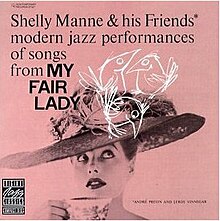My Fair Lady (Shelly Manne album)
| My Fair Lady | |||||
|---|---|---|---|---|---|
 |
|||||
| Studio album by Shelly Manne | |||||
| Released | 1956 | ||||
| Recorded | August 17, 1956 Contemporary Records Studio, Los Angeles, California |
||||
| Genre | Jazz | ||||
| Length | 35:56 | ||||
| Label |
Contemporary Records C 3527 |
||||
| Producer | Lester Koenig | ||||
| Shelly Manne chronology | |||||
|
|||||
| André Previn chronology | |||||
|
|||||
| Professional ratings | |
|---|---|
| Review scores | |
| Source | Rating |
| AllMusic | |
| The Rolling Stone Jazz Record Guide | |
My Fair Lady, recorded by "Shelly Manne & His Friends" and released in 1956 by Contemporary Records, is the first album ever made consisting entirely of jazz versions of tunes from a single Broadway musical. It was an instant hit and became one of the best-selling jazz albums of its day.
Shelly Manne & his Friends* (*André Previn and Leroy Vinnegar): modern jazz performances of songs from My Fair Lady, as the full name appeared on the 12-inch LP jacket (Contemporary Records C3527), was begun when drummer Shelly Manne, pianist André Previn, and bassist Leroy Vinnegar assembled on August 17, 1956, in the Contemporary studios in Los Angeles to produce an album of jazz versions of miscellaneous show tunes. (The three, having already recorded together as "Shelly Manne and His Friends", had some experience performing as a trio.)
Previn and Manne were exchanging ideas with producer Lester Koenig, who suggested they do some tunes from the current Broadway musical My Fair Lady. Manne and Previn were so impressed with the Lerner and Loewe songs for the show, that they decided to record more of them. They ended up filling the entire album with My Fair Lady tunes. Koenig brought in the complete score, and that evening Manne and Previn, between them, worked out the arrangements and recorded the entire album in one session, with Vinnegar providing the third "very important musical voice in the trio."
Lively and appealing, and clearly aimed at popular taste, the music also showed some daring, in the vein of the experimentation that was a factor in much West Coast jazz in the 1950s. Previn, with considerable musical training, and having composed several film scores himself, was able to suggest certain technical modifications to the harmony and other aspects of the music. Manne, as the date's leader, provided suggestions of his own, for example to treat what was a fast number in the show as a slow ballad instead. The final number, "I Could Have Danced All Night", was given a Latin touch, with Manne even adding the sound of a tambourine. "There was a total thing going back and forth," as Manne later put it.
...
Wikipedia
